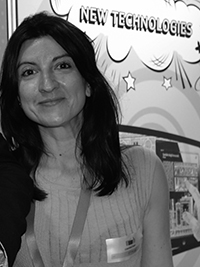Federica Maietti

XXI Cycle - (A.A. 2005-2006)
Architecture Technology
Home Institution: University of Ferrara
Scholarship
Curriculum: Architecture (ICAR12)
Research Topic: Technologies applied to Cultural Heritage
Tutor DA-UNIFE: Theo Zaffagnini
Nationality: Italian
Email: federica.maietti@unife.it
Profile
Biography
Federica Maietti is an Architect, Associate Researcher in the Scientific Sector ICAR17 at the Department of Architecture of the University of Ferrara, where she graduated in 2003, becoming a PhD in 2009. She is a member of the DIAPReM Centre (Development of Integrated Automatic Procedures for Restoration of Monuments) of the Department of Architecture of the University of Ferrara, of which she is responsible for Heritage documentation and diagnostic survey activities. As expert in integrated surveys and representation for the documentation of Cultural Heritage, in this area she develops researches in different contexts, including Pompeii, Malta, Brazil and India.
She is the Technical Coordinator of “INCEPTION - Inclusive Cultural Heritage in Europe through 3D semantic modelling”, ongoing H2020 project. She is the author of several articles and papers in journals, volumes and conference proceedings concerning integrated survey and representation, mainly focused on Cultural Heritage.
Research skills
Survey | Representation | Cultural Heritage | Digital Documentation | Diagnostic procedures
Scientific activities
ORCID ID:
0000-0002-8076-0020
IRIS UNIFE ID:
rp06861
Doctoral research
Trasparenza e Restauro (Transparency and Restoration. Theoretical/critical aspects, methods, materials and technologies for the protection and valorisation of historic/architectural heritage: from glass to synthetic materials)
The research starts from the concept of transparency, focusing on technological innovation for cultural heritage conservation, and in particular on methodologies, materials and technologies for protection and fruition through the use of synthetic materials with transparency properties. The concept of transparency, characteristic par excellence aimed at minimizing the "visual" impacts, is dealt under two significances: the material one and the theoretical-critical one, considering the principles of minimum intervention, reversibility, authenticity, distinguishability and physical-chemical compatibility. The interdisciplinary significance of the thesis includes documentation, survey and diagnostic investigations aimed at analysing the surface characteristics of the architectural heritage and its conservation. A large part of the research has been developed within the archaeological site of Pompeii. Following the advanced diagnostic survey on the facades of Via dell'Abbondanza, the thesis deepened design solutions, currently in operation, which provide transparent and technologically advanced protection devices in order to guarantee the visibility, use and enhancement of the wall paintings ensuring an appropriate microclimate between slabs and historical surfaces. Several issues have been considered, including weathering, temperatures, solar irradiation, wind, moisture, biological and chemical damages, pollution, anthropic degradation. Moreover, the research deepened the spectrophotometric survey performed on the wall paintings: the database achieved and aimed at monitoring has been the starting point for a comparison between the conditions of the historical surfaces after the restoration works, with surveys carried out in different periods following the transparent slabs application.
Keywords
Heritage | Conservation | Transparent materials | Documentation | Integrated Survey

